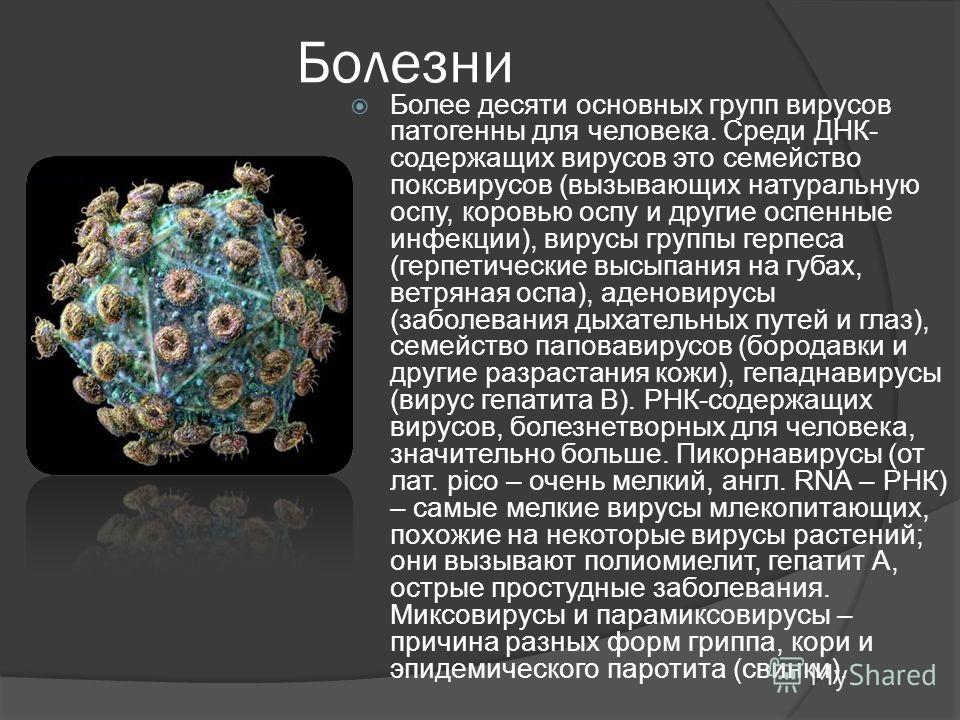Goal: the formation of students' knowledge about extracellular life forms - viruses.
Lesson type: learning new material
Equipment: table "Structure of viruses", "Bacteriophages", multimedia presentation, computer.
Mind and health are the most precious thing.
During the classes:
I. Organizing time
II. Updating the topic. Statement of the problematic question.
In winter, we hear such information that there is an outbreak of influenza, viruses quickly infect people, and vaccinations against influenza do not help much. Why it is difficult to protect yourself from seasonal flu, why the disease spreads quickly, we will try to find out today. Let's put in front of ourselves problematic issue - why is it difficult to fight against viruses - causative agents of diseases and completely destroy them?
III. The main stage
It is an organism that lives off its owner.
How did the discovery of viruses come about? Who opened them?
(Listening to student messages)
Student 1: The story of the discovery of viruses... End of the 19th century. Bacteriology has made great strides. During this period, scientists discovered the causative agents of plague, cholera, tuberculosis, diphtheria and other most common and widespread diseases. However, the causative agents of many other diseases, including very dangerous ones (for example, measles, smallpox, influenza, hepatitis, etc.), could not be detected, although they knew about the diseases for a long time.
In 1892, Dmitry Iosifovich Ivanovsky (1864 - 1920), while searching for the causative agent of tobacco mosaic disease (leaf disease of the tobacco plant), found that it was not visible under a microscope even at high magnification and passed through filters that retain bacterial cells; it does not grow on conventional artificial culture media used in bacteriology. The tobacco juice passed through the filter has not lost its infectious properties.
Many years later, scientists learned that viruses are 50 times smaller than bacteria, so they freely passed through the filter. Ivanovsky called open organisms "filterable microbes" and identified two main properties of viruses: they are very small, and unlike cells, they cannot be grown on artificial nutrient media.
Six years later, in 1898, independently of Ivanovsky, the Dutch microbiologist M. Beijerink obtained the same results. He concluded that the disease mosaic of tobacco is caused not by microbes, but by a “liquid infectious principle,” or a filterable virus that multiplies only in living organisms. Both scientists were partly right, but partly wrong. The causative agent of the tobacco disease was not bacteria, as Ivanovsky argued, but also not a liquid infectious principle, as Beijerinck suggested. The cause of the disease was viruses - special organisms (from the Latin "virus" - poison). The size of viruses is from 20 to 300 nm, they could be seen only with the help of an electron microscope in the 30s of the XX century, they are about 50 times smaller than bacteria. Viruses enter the Vira kingdom, and are ubiquitous. The first to be photographed was the tobacco mosaic virus, which is the most studied. The discovery of viruses laid the foundation for a new science - virology, which studies non-cellular forms organisms.
Teacher: Viruses are very different from other living organisms. Viruses are a special and unique form of life, albeit a primitive one. Viruses are often called a transitional form between organisms of animate and inanimate nature. When a virus is in a host cell, it behaves like a living organism, it is in an intracellular form, and forms a complex "virus - host cell". If the virus is outside the host cell, in a dormant extracellular form, it is a viral particle or virion, in this case, the virus does not show signs of a living organism. (Notes in a notebook)
Forms of viruses can be different: filamentous, spherical, rod-shaped, polygonal, cubic, in the form of a crystal. Individual viral particles - virions - are symmetrical bodies, inside each virion there is genetic material in the form of DNA or RNA. (Notes in a notebook)
Virus appearance shown on page 38 fig. 15 - herpes virus and influenza virus, in Fig. 16 is a model of the tobacco mosaic virus. (Work with the textbook Kamensky A.A. Kriksunov E.A. Pasechnik V.V. Biology. Introduction to general biology and ecology 9th grade)
Any virus is a protein coat that protects against the action of enzymes that destroy nucleic acids - capsid(from the Latin word "capsa" - a container). (Notes in a notebook) The capsid contains receptors that recognize similar receptors in the cell membrane of the "host cell", therefore viruses infect a strictly defined range of hosts. Inside the capsid are nucleic acid strands, either DNA or RNA, they carry hereditary information. DNA and RNA can be single-stranded or double-stranded. Typically, in plant or animal cells, hereditary information is concentrated in the DNA molecule, and in viruses either in DNA or RNA.
Scientists have a question, what kind of viruses - living or nonliving organisms?
Let's identify the similarities and differences between viruses and living organisms. Fill in the table using page 38 of the Biology textbook, author A.A. Kamensky. Kriksunov E.A. & 1.9. We read aloud the first paragraph and fill in the table.
Characteristic features of viruses
Similarity to living organisms
Differences from living organisms
Virus-specific traits
1.the ability to reproduce similar forms (to reproduce)
2.is hereditary
3.variability
4.adapt to changing environmental conditions
1.do not exhibit the properties of living
2.do not consume food
3.do not generate energy
4.do not grow
5.no metabolism
6. have the form of crystals, do not have a cellular structure, i.e. no cytoplasmic membrane and cytoplasm with organelles
1.very small size
2.simple structure - nucleic acid (DNA or RNA) enclosed in a protein shell - capsid
3. occupy a borderline position between living and nonliving matter
4.high reproduction rate
5.hereditary information is in DNA or RNA
Viruses are autonomous genetic structures that have the main characteristics of living organisms: reproduction, variability and heredity. On the other hand, viruses do not have important properties of living things - they do not feed, do not grow, there is no metabolism and are not capable of independent reproduction outside the host cell. They differ from all organisms in that they have a protein shell - a capsid, and within the sarcophagus there is hereditary information in the form of DNA or RNA strands.
Virus classification... All viruses are conventionally divided into two groups:
simple 2. complex. (Notes in a notebook)
Simple ones are composed of a nucleic acid (DNA or RNA) and a protein coat (capsid) that covers them, such as the tobacco mosaic virus. Complex viruses on the surface of the capsid also have an outer shell - a membrane containing lipids, proteins and carbohydrates, for example, the influenza and herpes virus.
By the presence of this or that nucleic acid, viruses are called DNA-containing or RNA-containing. DNA-containing - they contain a DNA molecule in the form of a chain or a ring, which stores hereditary information - these are viruses of human pox, sheep, pigs and herpes. RNA-containing - they contain an RNA chain that stores genetic information. These are the viruses of rabies, encephalitis, rubella, measles, AIDS, leukemia and flu. Some viruses may not have a shell at all.
How do viruses get into cells and how do they behave, penetrating into cells of other organisms? See page 39 fig. 17 biology textbooks.
Viruses enter the cell along with droplets of intercellular fluid. Each virus is able to penetrate only to certain cells that have special receptors on their surface. Then, penetration into the host cell begins. Mechanical damage to the cell wall or membrane helps viruses penetrate into the cell, and the method of pinocytosis and phagocytosis is also possible. Unlike cellular organisms, viruses do not have their own system that synthesizes proteins. When viruses enter the cell, they contribute their genetic information. Penetrating into the cell, the virus changes its metabolism, directing all activity to the production of viral nucleic acid and viral proteins. Self-assembly of viral particles from the formed nucleic acid molecules and proteins occurs inside the cell. The accumulation of viral particles leads to their exit from the cell by "explosion", as a result of which the integrity of the cell is violated and it dies, and viruses begin to penetrate into other cells.
Viruses infect all living organisms - plants, animals and humans and cause disease. (Listening to student messages)
Student 2: Currently, more than 1,000 different types of viruses have been described. Viruses as causative agents of diseases in humans, animals and plants have been known since ancient times.
In 1916, the Canadian bacteriologist Felix D'Herelem described bacteria viruses - bacteriophages. They have become the most important research object in molecular biology. Bacteriophages or phages are capable of entering bacteria cells and destroying them. Bacterial viruses have a head containing DNA and a tail with tail filaments. Bacteriophages are similar in structure to a syringe. The phage partially dissolves the cell wall and membrane of the bacterium, introduces a hollow rod into the cell and, through a contractile reaction, injects its DNA into its cell. The genome of the bacteriophage enters the cytoplasm, while the membrane remains outside. The DNA molecule of viruses can be incorporated into the genome of the host cell and exist for a long time.
There are more than 500 types of viruses in animals that cause diseases such as foot and mouth disease, swine and bird distemper, equine infectious anemia, avian and swine flu, and others. The foot and mouth disease virus spreads with the speed of a chain reaction, capable of destroying animal husbandry on a national scale. A similar catastrophe was observed in late 2000 in the UK, when the FMD virus infected cattle in that country. Currently, a huge number of wild and domestic birds in many countries of the world die from the bird flu virus.
More than 300 types of viruses are known that cause diseases in plants, such as mosaic disease of tobacco, tomatoes, cucumbers, leaf curling, dwarfism and others.
More than 500 types of viruses can cause a variety of infectious diseases human such as flu, mumps, polio, rabies, measles, AIDS and many others. In past centuries, viral infections were in the nature of devastating epidemics and pandemics, covering vast territories. In Moscow in the XIII century, smallpox destroyed almost 80% of the population. Herpes viruses infect human skin. Most often it manifests itself with a cold on the lips. At rest, the herpes virus can stay in cells for a long time and wait in the wings. Diseases viral nature widespread at the present time.
Teacher:By settling in the cells of living organisms, viruses cause many dangerous diseases. Many advances in virology have been made in the fight against specific diseases - smallpox, tick-borne encephalitis, rabies, yellow fever, and other diseases. Mankind faces many virological problems and their solution requires knowledge of the various properties and "habits" of viruses.
Viral diseases transmitted in two ways: by direct contact (contagious) and by airborne droplets. Few diseases are transmitted through direct physical contact with sick people or animals. Such viral diseases include, for example trachoma - eye disease, very common in tropical countries, common warts and herpes common.
Drip infection is the most common way of spread respiratory diseases... When you cough or sneeze, millions of small droplets of saliva and mucus are thrown into the air. These drops, together with the living microorganisms in them, can be inhaled by other people and get sick. Hygienic requirements for protection against droplet infection are the use of a handkerchief and bandage, as well as the observance of sanitary cleanliness.
Some microorganisms, such as smallpox virus, are very resistant to drying out and remain in dust containing dried droplet residues.
Some dangerous viruses have spread in recent years, such as AIDS, influenza and its various varieties. (Listening to student messages)
Student 3: AIDS
In 1981, a new disease, previously unknown to science, appeared, which received the name - acquired immunodeficiency syndrome - AIDS for short. The causative agent of AIDS is the human immunodeficiency virus - HIV. It has a spherical shape with a diameter of 100 - 150 nm. The outer envelope of the virus consists of a membrane formed from the cell membrane of the host cell. Receptor formations are built into the membrane, resembling mushrooms in appearance. Under the outer shell is the virus capsid, formed by special proteins, inside which there are two molecules of viral RNA. Each RNA molecule contains 9 HIV genes and an enzyme that synthesizes DNA from the viral RNA molecule.
First of all, HIV infects T - blood lymphocytes (helpers), on the surface of which there are receptors capable of binding to HIV proteins. T-lymphocytes of blood provide a person with cellular and humoral immunity. HIV enters the cells of the central nervous system, intestines, cells, neurons. As a result, the human body loses its protective properties and is unable to resist the causative agents of various infections. The average life span of an infected person is 7 to 10 years.
The source of AIDS infection is a person who is a carrier of the immunodeficiency virus. It can be a patient with various manifestations of the disease or an asymptomatic virus carrier. AIDS is transmitted only from person to person in the following ways: 1. sexually 2. through blood and tissues containing the virus 3. from mother to fetus. HIV can enter the body through sexual contact with a sick person, through the introduction of intravenous drugs, through a blood transfusion from an infected donor. There are known cases of infection of children during childbirth and through the milk of a sick mother.
Despite the fact that the AIDS virus is found in the secrets of the human body (in saliva, tears, milk), there is no evidence of its transmission through everyday contact.
In recent years, there has been an increase in the number of HIV - infected people in Russia. The overwhelming majority of them are young people. The problem of combating AIDS remains one of the most important for society and for health care. (Listening to student messages)
Student 4: Influenza, flu types.
A person who has been vaccinated and has had the flu develops immunity, that is, antibodies are produced in the blood plasma that will block the virus and the person will remain healthy. But, unfortunately, influenza viruses are highly variable, they mutate. Vaccine antibodies act against a certain type of influenza virus and are absolutely powerless against another type of virus. The modified flu virus needs a different vaccine, which is why influenza viruses are so difficult to fight.
This is why every year the flu epidemic catches us by surprise again and again. Influenza viruses are especially active in autumn and winter. Even "ordinary" flu can cause serious complications - pneumonia, heart failure. Epidemics are not as bad as pandemics - they are a global epidemic that affects most of the world's population. Among the massive pandemics - the worldwide flu epidemic (then it was called "Spanish flu", according to scientific H 1N 1) in 1918 - 1919, it struck up to 500 million people and claimed up to 40 million human lives. In the 20th century, an influenza pandemic struck humanity in 1918, 1957 and 1968, the likelihood of another pandemic is very high.
Influenza viruses are divided into three groups - A, B and C. Virus C is the most harmless, the disease proceeds easily and without complications. Group B virus is dangerous, causing epidemics on a regional scale. Virus A - causes the most severe course of the disease and can cause world epidemics. Bird flu, swine flu also belongs to group A, they are capable of replacing parts of the human genome with the genes of the avian or swine flu virus.
Despite the fact that the 1918 Spanish flu pandemic occurred in the era of scientific and technological progress, the pedigree of that deadly virus is still unknown. Scientists studied strains of the Spanish flu virus and came to the conclusion that the virus was of avian origin, but very close to the swine flu virus. The cause of this virus's deadly power has not yet been established.
In 2008 - 2009, cases of avian and swine flu, both among animals and among people, were again registered in different countries of the world. Influenza viruses are much more resistant to fever than viruses that cause the common cold. That is why they are more dangerous: the virus can multiply even when high temperature, it is difficult for the patient to deal with it.
To avoid infection with the usual flu, avian and swine, you need to play sports, strengthen immunity, in case of infection, consult a doctor and carry out timely treatment.
IV. conclusions
Teacher: Let's do output, we met today in the lesson with very small but dangerous organisms that occupy a borderline position between living and nonliving organisms - viruses. They are the cause of many diseases that occur in plants, animals, carry dangerous diseases person.
Let's remember problematic issue, which we put at the beginning of the lesson and will try to answer it. Why is it difficult to fight against viruses - pathogens of diseases and completely destroy them?
Reasons (answer):
small size
adapt quickly
are embedded in foreign cells and completely subjugate them, (cells begin to synthesize the genetic material of the virus)
changeable, rapidly changing, mutating
V. Securing new material
Teacher:Guys, after listening to information about the amazing organisms of the invisible world - viruses, draw a conclusion in the form of syncwine. You work in pairs, on desks and draw up the cinquain on sheets of paper with a felt-tip pen. You work for 3-4 minutes.
Sinkwine (from the French word for "five lines"). Sinkwine is a poem that requires a large amount of educational information in short terms, which allows you to draw a conclusion. The guys can do this work in pairs or individually, you can artistically arrange a sheet with syncwine. This is a five-line poem, which is built according to certain rules.
1.the name of the syncwine is a topic, usually one word (noun, what?)
2.description of the topic in a nutshell (adjective, adjective (what?))
3.description of the action within the topic in three words (verb, verb, verb (what does it do?))
4. a phrase showing attitude to the topic, "catch phrase" on the theme of syncwine
5.a word that repeats the essence of the topic (noun)
Example syncwine:
2. Small, dangerous
3. Reproduce, adapt, carry disease
4. Viruses are non-cellular organisms
Independent work (Orally)
Complete the sentences by inserting the missing words.
The hereditary information of the virus is in a single-stranded or double-stranded molecule …… .. (DNA or RNA)
The core of the virus is surrounded by a protective protein envelope called ... ... .. (capsid)
Viruses of bacteria are called …… .. (bacteriophage)
The science that studies the structure and behavior of viruses ……. (virology)
One of the ways of transmission viral infection contagious, i.e. ………. (contact)
Teacher: Homework & 1.9. Lesson grades. Thank you for the lesson!
The discovery of viruses by D.I. Ivanovsky in 1892. laid the foundation for the development of the science of virology. Its more rapid development was facilitated by: the invention of the electron microscope, the development of a method for cultivating microorganisms in cell cultures.
Currently, virology is a rapidly developing science, which is associated with a number of reasons:
The leading role of viruses in human infectious pathology (examples are influenza virus, HIV, human immunodeficiency virus, cytomegalovirus and other herpes viruses) against the background of an almost complete absence of specific chemotherapy agents;
Using viruses to solve many fundamental questions in biology and genetics.
The main properties of viruses (and plasmids), by which they differ from the rest of the living world.
1. Ultramicroscopic dimensions (measured in nanometers). Large viruses (smallpox virus) can reach 300 nm, small viruses from 20 to 40 nm. 1 mm \u003d 1000 μm, 1 μm \u003d 1000 nm.
3. Viruses are not capable of growth and binary fission.
4. Viruses reproduce by reproducing themselves in an infected host cell using their own genomic nucleic acid.
6. The habitat of viruses is living bacterial cells (these are bacteria viruses or bacteriophages), plant, animal and human cells.
All viruses exist in two qualitatively different forms: extracellular- virion and intracellular- virus. The taxonomy of these representatives of the microworld is based on the characteristics of virions, the final phase of the development of viruses.
The structure (morphology) of viruses.
1. Genome of viruses form nucleic acids, represented by single-stranded RNA molecules (in most RNA viruses) or double-stranded DNA molecules (in most DNA viruses).
2. Capsid - the protein envelope in which the genomic nucleic acid is packed. The capsid consists of identical protein subunits capsomers. There are two ways of packing capsomers into capsid - spiral (spiral viruses) and cubic (spherical viruses).
With spiral symmetry protein subunits are arranged in a spiral, and between them, also in a spiral, is folded genomic nucleic acid (filamentous viruses). With cubic symmetry virions can be in the form of polyhedra, most often - twenty-hedrons - icosahedrons.
3. Viruses simply arranged have only nucleocapsid, i.e. complex of the genome with the capsid and are called "naked".
4. Other viruses have an additional membrane-like envelope on top of the capsid, which is acquired by the virus at the moment it leaves the host cell. supercapsid.Such viruses are called “clothed” viruses.
In addition to viruses, there are even simpler forms of transmissible agents - plasmids, viroids and prions.
The main stages of the interaction of the virus with the host cell.
1. Adsorption is a trigger mechanism associated with the interaction specific receptors of the virus and the host (in the influenza virus - hemagglutinin, in the human immunodeficiency virus - glycoprotein gp 120).
2. Penetration - by fusion of the supercapsid with the cell membrane or by endocytosis (pinocytosis).
3. Release of nucleic acids - “stripping” of the nucleocapsid and activation of the nucleic acid.
4. Synthesis of nucleic acids and viral proteins, i.e. subordination of host cell systems and their work for the reproduction of the virus.
5. Assembly of virions - association of replicated copies of viral nucleic acid with capsid protein.
6. Release of viral particles from the cell, acquisition of supercapsid by enveloped viruses.
Outcomes of the interaction of viruses with the host cell.
1. Abortive process- when cells are cleared of the virus:
When infected defective a virus that requires a helper virus to replicate, these viruses cannot replicate independently (so-called virusoids). For example, the hepatitis delta (D) virus can replicate only in the presence of hepatitis B virus, its Hbs - antigen, adeno-associated virus - in the presence of adenovirus);
When a virus infects genetically insensitive cells to it;
When susceptible cells are infected with a virus under non-permissive conditions.
2. Productive process- replication (production) of viruses:
- cell death (lysis) (cytopathic effect) - the result of intensive reproduction and the formation of a large number of viral particles - a characteristic result of the productive process caused by viruses with high cytopathogenicity. The cytopathic effect of action on cell cultures for many viruses is quite recognizable and specific;
- stable interactionthat does not lead to cell death (persistent and latent infections) - the so-called viral transformation of the cell.
3. Integrative process- integration of the viral genome with the host cell genome. This is a special version of a productive process of the type of stable interaction. The virus replicates along with the genome of the host cell and can remain latent for a long time. Only DNA viruses can integrate into the host's DNA genome (the “DNA-in-DNA” principle). The only RNA viruses capable of integrating into the genome of the host cell, retroviruses, have a special mechanism for this. The peculiarity of their reproduction is the synthesis of provirus DNA based on genomic RNA using the reverse transcriptase enzyme, followed by DNA integration into the host genome.
Basic methods of virus cultivation.
1. In the body of laboratory animals.
2. In chicken embryos.
3. In cell cultures - the main method.
Types of cell cultures.
1. Primary (trypsinized) cultures- fibroblasts of a chicken embryo (FEC), a human (FEC), kidney cells of various animals, etc. Primary cultures are obtained from cells of various tissues more often by crushing and trypsinization; they are used once, i.e. it is always necessary to have the appropriate organs or tissues.
2. Diploid cell lines are suitable for redispersion and growth, usually no more than 20 passages (lose their original properties).
3. Twisted lines (heteroploid cultures), capable of multiple dispersion and transplantation, i.e. to multiple passages, are most convenient in virological work - for example, lines tumor cells Hela, Hep et al.
Special nutrient media for cell cultures.
A variety of synthetic virological nutrient media of complex composition are used, including a large set of different growth factors - medium 199, Eagle, Hanks solution, lactalbumin hydrolyzate. PH stabilizers (Hepes), different species of blood serum (the most effective are considered fetal calf serum), L-cysteine \u200b\u200band L-glutamine are added to the media.
Depending on the functional use of the environment, there may be growth (with a high serum content) - they are used to grow cell cultures before viral samples are introduced, and supporting (with less or no whey) - to contain infected with the virus cell cultures.
Detected manifestations of viral infection of cell cultures.
1. Cytopathic effect.
2. Identification of inclusion bodies.
3. Detection of viruses by the method of fluorescent antibodies (MFA), electron microscopy, autoradiography.
4. Color test. The usual color of culture media used, containing phenol red as an indicator of pH, is red under optimal culture conditions for cells (pH about 7.2). Reproduction of cells changes the pH and, accordingly, the color of the medium from red to yellow due to a shift in pH to the acidic side. When viruses multiply in cell cultures, cell lysis occurs; there is no change in the pH and color of the medium.
5. Revealing hemagglutinin of viruses - hemadsorption, hemagglutination.
6. Method of plaques (plaque formation). As a result of the cytolytic action of many viruses on cell cultures, zones of mass cell death are formed. Plaques - viral "cell-negative" colonies are detected.
Virus nomenclature.
The name of the family of viruses ends with “viridae”, genus- “virus”, special names are usually used for the species, for example - rubella virus, human immunodeficiency virus - HIV, human parainfluenza virus type 1, etc.
Bacterial viruses (bacteriophages).
The natural habitat of phages is a bacterial cell, therefore phages are ubiquitous (for example, in sewage). Phages have biological characteristics similar to other viruses.
The most morphologically widespread type of phage is characterized by the presence of an icosahedron head, an appendix (tail) with spiral symmetry (often has a hollow shaft and a contractile sheath), spines and processes (filaments), i.e. outwardly somewhat resemble a sperm.
The interaction of phages with a cell (bacterium) is strictly specific, i.e. bacteriophages are capable of infecting only certain species and phage types bacteria.
The main stages of interaction between phages and bacteria.
1. Adsorption (interaction of specific receptors).
2. The introduction of viral DNA (phage injection) is carried out by lysing a section of the cell wall with substances such as lysozyme, reducing the sheath, pushing the tail shaft through the cytoplasmic membrane into the cell, and injecting DNA into the cytoplasm.
3. Reproduction of a phage.
4. Exit of daughter populations.
Basic properties of phages.
Distinguish virulent phagescapable of causing a productive form of the process, and temperate phagescausing reductive phage infection (phage reduction). In the latter case, the phage genome in the cell is not replicated, but is introduced (integrated) into the chromosome of the host cell (DNA into DNA), the phage turns into prophage. This process was named lysogeny... If, as a result of the introduction of a phage into the chromosome of a bacterial cell, it acquires new inherited traits, this form of bacterial variability is called lysogenic (phage) conversion. A bacterial cell carrying a prophage in its genome is called lysogenic, since a prophage, if the synthesis of a specific repressor protein is disturbed, can enter the lytic development cycle, causing a productive infection with bacterial lysis.
Moderate phages are essential in the exchange of genetic material between bacteria - in transduction (one of the forms of genetic exchange). For example, the ability to produce exotoxin is possessed only by the causative agent of diphtheria, in the chromosome of which a moderate prophage is integrated, carrying operon tox, which is responsible for the synthesis of diphtheria exotoxin. Mild tox phage induces lysogenic conversion of a nontoxigenic diphtheria bacillus into a toxigenic one.
By spectrum of action phages are divided into bacteria into:
Polyvalent (lyse closely related bacteria, such as salmonella);
Monovalent (lyse bacteria of the same species);
Type-specific (lyse only certain phagovars of the pathogen).
On solid media, phages are more often detected using a spot test (the formation of a negative spot during the growth of colonies) or by the method of agar layers (titration according to Grazia).
Practical use of bacteriophages.
1. For identification (definition of phage type).
2. For phage prophylaxis (arresting outbreaks).
3. For phage therapy (treatment of dysbacteriosis).
4. For environmental health assessment and epidemiological analysis.

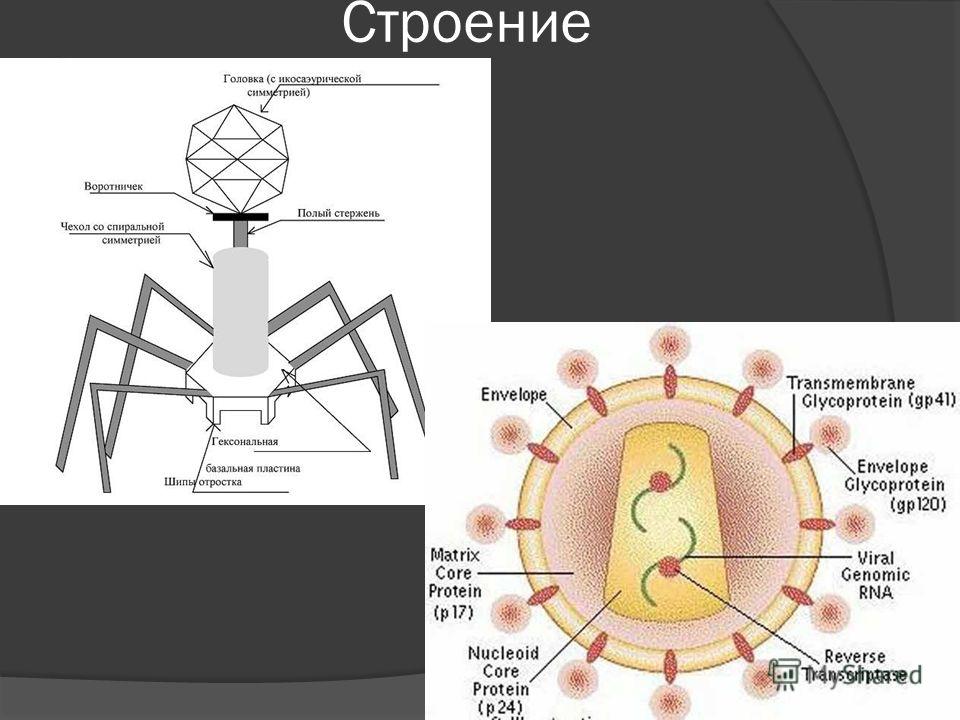
Replication Genetic information encoded in a single gene can generally be seen as instructions for the production of a specific protein in a cell. Such an instruction is perceived by the cell only if it is sent in the form of mRNA. Therefore, cells in which the genetic material is represented by DNA must "rewrite" (transcribe) this information into a complementary copy of mRNA. DNA-containing viruses in the way of replication differ from RNA-containing viruses. Viral replication involves three processes: viral nucleic acid replication, viral protein synthesis, and virion assembly.
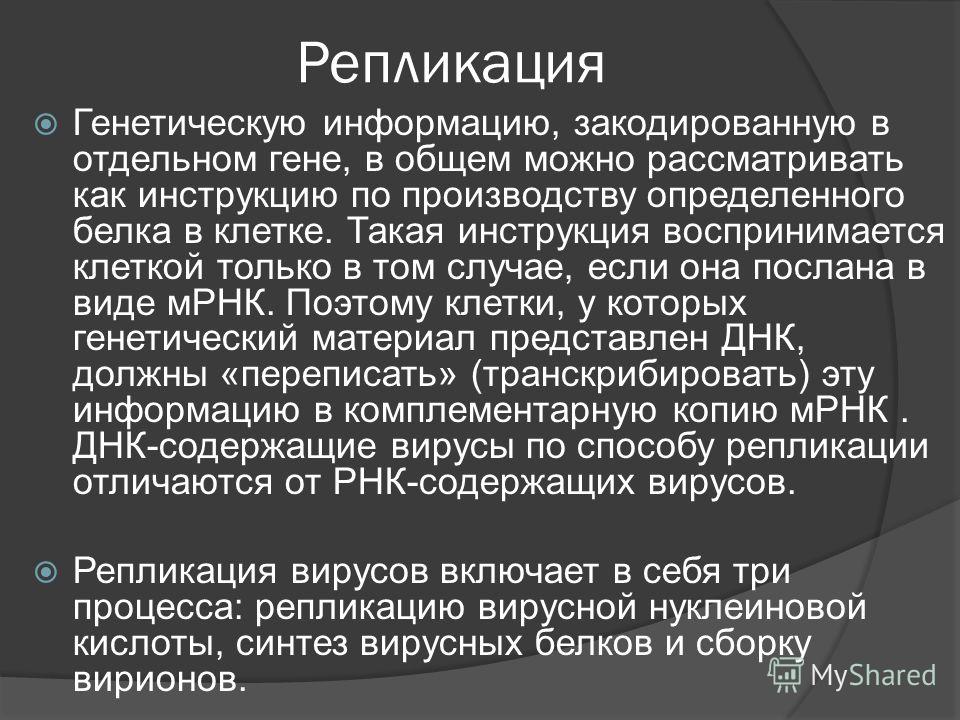
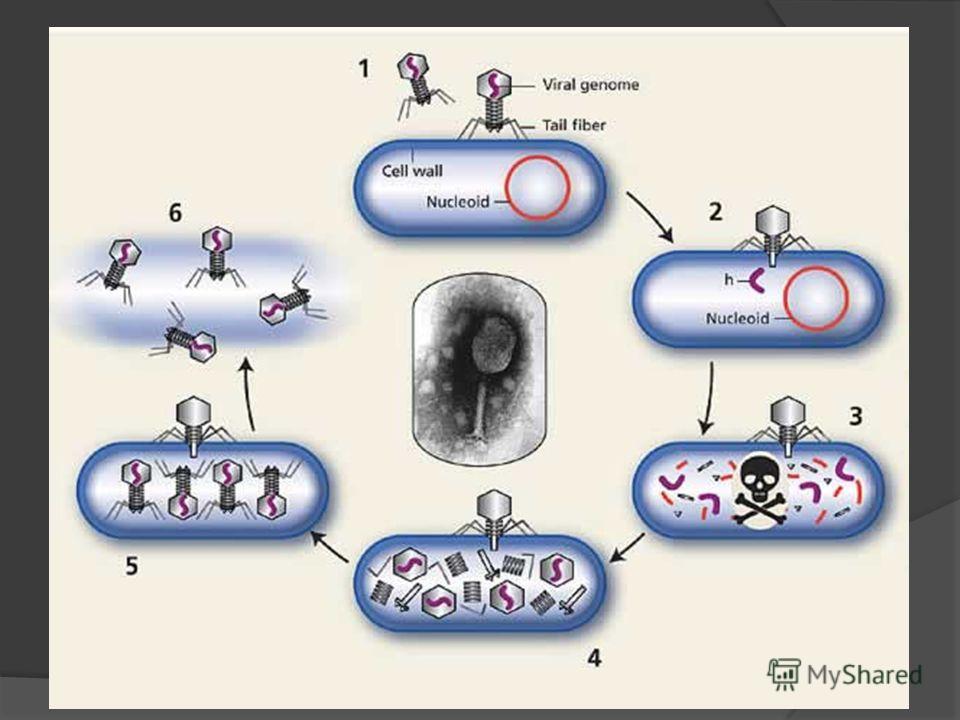
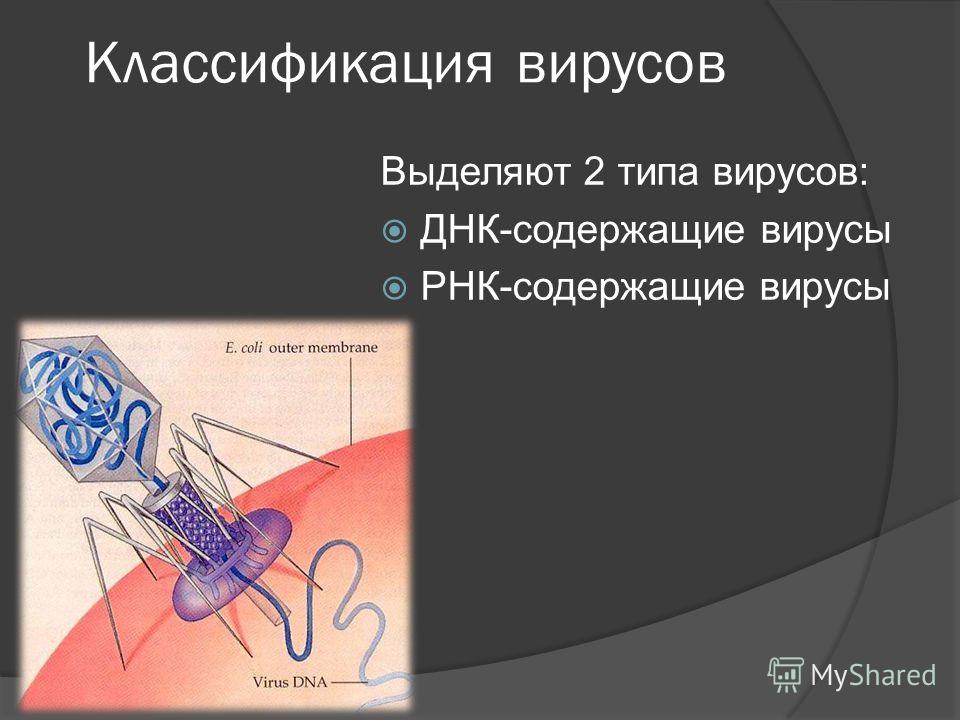
Diseases More than ten major groups of viruses are pathogenic for humans. Among the DNA-containing viruses, this is the family of poxviruses (causing smallpox, vaccinia and other smallpox infections), viruses of the herpes group (herpes sores on the lips, chickenpox), adenoviruses (diseases respiratory tract and eyes), the papovavirus family (warts and other growths of the skin), hepadnaviruses (hepatitis B virus). There are much more RNA-containing viruses that are pathogenic for humans. Picornaviruses (from Latin pico - very small, English RNA - RNA) are the smallest mammalian viruses, similar to some plant viruses; they cause poliomyelitis, hepatitis A, acute colds... Mixoviruses and paramyxoviruses are the cause of various forms of influenza, measles and mumps (mumps).
